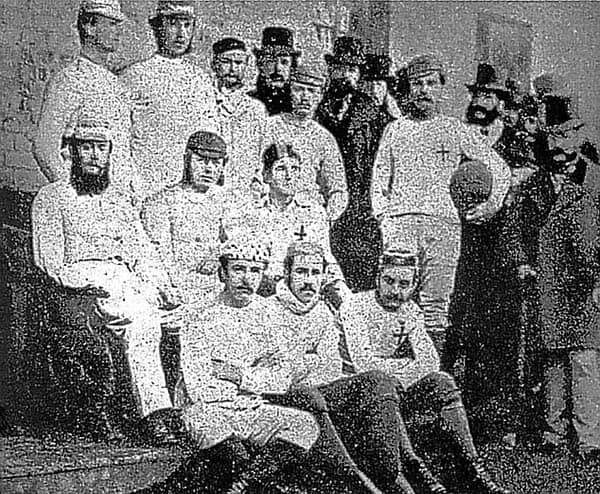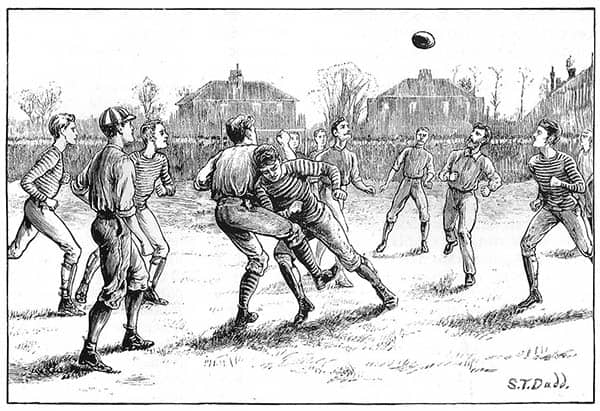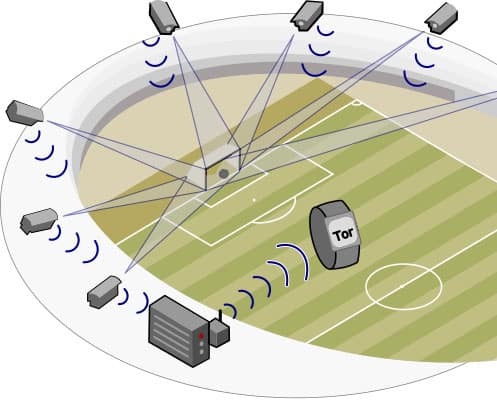Technology and Tradition Will Shape the Centuries: From Mob to Modern Football. There have been football games for ages. We’ll explore “ How Football Has Evolved Through Centuries: Metamorphosis Through the Ages”. From being a medieval game played in the streets by young apprentices, football is a global phenomenon that millions watch and participate in daily.

Unsurprisingly, we find this sport fascinating, so we chose to look at how it has changed over time. Exploring the factors driving non-cricket sports, the impact they’re having, and what the future holds. So join us on a voyage through time if you’re curious to understand more about the development of this fantastic sport.
Also Read:
- Why India Is the Perfect Host for the 2023 Cricket World Cup
- 12 Latest Indian Fashion Trends 2023: Slaying with Chic and Stylish
The History of Football in the Ancient World

Football has been a popular sport around the world for ages. Its origins are in Chinese, Greek, and Roman antiquity. Football’s first version is considered to have been played in China during the second and third centuries BC. Football originated in the Middle Ages, but the ancient Greeks and Romans played several ball-kicking sports.
Football was far from being a well-organized team sport at this time, with hardly any rules or scorekeeping. Like modern rugby, the ball was typically created with an interior bladder carrying air and could be kicked or thrown with the feet, hands, or head. Medieval peasants frequently gathered to play this archaic variant of football on Sundays after church services ended.
Since then, football has experienced a significant transformation and is now a global pastime for millions of people. Football has come a long way, from its humble beginnings in rural pastures to its contemporary worldwide prominence.
Is it football or soccer? Why all the fuss?
This is a common query in the sports world seeking clarification. The solution is not that easy. The sport has changed and evolved over many centuries, eventually adopting a variety of titles depending on where it is played. It is known as football in some regions, football in others, and something completely different.
As time passed, more rules were added and altered depending on where you played in the world, making it increasingly difficult to combine all of these variants into a single, consistent set of rules.
Global organizations like FIFA have fortunately been able to create a set of unified rules between all countries, allowing everyone around the world to appreciate and enjoy a good game of football (or football! ), thanks to new innovative technologies used in the game like video replay and virtual assistant referees.
Modern Football’s Development in the 19th Century in England
Since its inception centuries ago, English football has seen an amazing transformation. Pockets of fervent players around England contributed to the game’s growth and popularity in the 19th century.
The top and middle classes took up football between 1820 and 1830. Boys from neighborhood schools would frequently play this sport in fields near their homes at the time. Ebenezer Cobb Morley prepared the rules for modern football. In October 1863, Morley published a letter to Bell’s Life outlining regulations for a new game called “association football” (now known as soccer).

Source- https://commons.wikimedia.org
A fresh invention was required since the agricultural calendar made holding matches at specific year periods difficult. In response, football clubs instituted training regimens and warm-up activities. Players also started wearing gloves to give themselves a better grip on the ball. From 1864 onward, spectator attendance at games increased significantly, which made it simpler for clubs to achieve financial independence. As a result, teams received increased funding to construct stadiums with superior infrastructure.
The FA Cup and the Early Days of Professional Football
Did you know that football was exclusively an amateur activity for the first 100 years of its existence, with public schools dominating the sport? However, things began to change in the late 1800s when a group of forward-thinking Englishmen decided to establish the Football Association (FA) in October 1863, establishing the oldest football organization in the world.
The Football Association Cup, now commonly called the FA Cup, was one of the FA’s initial projects and is still played annually.
In addition to this competition, other regional leagues were established, transforming football from an amateur sport to a professional one with adequate management and organization. This opened the door for improved mechanics and rules, which eventually found their way into FIFA Laws.

Photo by Daniel Norin on Unsplash
The Globalization of Football: The Beautiful Game
Over the past couple of centuries, football has experienced significant growth in popularity. Businessmen, railway workers, and others with adequate money and free time to dedicate to an organized form of football had started to take an interest in it by the late 1800s.
Football goes Global!
In the early 1900s, various football teams were founded in nations like France and Spain as the game spread outside Britain. Media coverage quickly followed, with newspapers and magazines hurrying to report on its rising popularity throughout Europe and the rest of the world.
Football is currently one of the most popular sports in the world. Over 270 million players are reportedly active worldwide. More than four billion people watch some or all major competitions like the World Cup or the UEFA Champions League Finals. It had even brought together different nations, as seen when South and North Korea marched together during the 2018 World Cup!
New Innovations
- But let’s not overlook how technological advancements have helped football achieve new heights of popularity and reach today. For instance:
- Watching live events from anywhere worldwide is now possible; 2. More and more games are being aired on smartphones;
- Wearable technology helps teams monitor athletes’ performance in real time;
- Artificial intelligence (AI) is now being used for higher accuracy in referee decision making;
- And social media platforms such as Twitter are now integral parts of live match coverage!
Football in India
Well, for starters, cricket runs in our veins. But equally important for millions is footbal. Few nations have a more extensive history in football than India. Football has at least a 200-year history in India, where its appeal has grown. British colonial newspapers began covering the sport as early as 1895.
The Indian Super League (ISL), the top division of professional clubs, attracts millions of viewers each year, demonstrating how popular football has become in India today. The ISL matches are now broadcast on TV and online, making it simple for fans to watch from wherever they are. This has contributed to the ISL’s popularity boom.
India is likewise making efforts to develop players of the highest caliber. The All India Football Federation (AIFF) is creating numerous youth and grassroots programs to promote football and attract fresh talent nationwide.

Advances in technology are changing the face of football.
Over the centuries, football has advanced significantly, and this is due to more factors than just rule modifications or the establishment of leagues. Additionally, Technology is becoming more and more important.
VAR, or video assistant referee
The Video Assisted Referee (VAR) is one of the most notable recent technological advancements. The 2018 World Cup saw the introduction of VAR. This supports game fairness by assisting referees in making educated judgments about the plays.
Goal Line Technology (GLT)
Goal Line Technology (GLT) is a significant football innovation. During the 2014 World Cup, FIFA first implemented GLT. When it comes to setting legal objectives, this technology has helped decrease human mistakes, resulting in much fairer outcomes.
Both developments show how football has accepted new technology, resulting in more equitable gameplay for all parties. As we continue to innovate and advance, it’s thrilling to consider what additional technologies might be applied to football in the upcoming years!

What does the future hold for football?
What does the future of football hold? We’ve seen how the game has evolved throughout the years. Here are a few things I predict will spread more in the next few years.
Future Technologies
Football has evolved significantly thanks to technology, and this trend doesn’t appear to be changing anytime soon. Fans may already enjoy an immersive viewing experience from the convenience of their homes thanks to artificial intelligence, 5G networks, and virtual reality.
Augmented Reality
Fans might view and interact with 3D virtual components superimposed over a live stadium setup using augmented reality (AR) technology. Consider life-size figures appearing on the sidelines as a part of a virtual experience or augmented reality replays that allow spectators to get precise positional data.
Science and analytics’ effects
Football teams increasingly rely on analytics to get an advantage over their opponents. There’s no knowing how far we can advance football in the future by testing cutting-edge technologies like drones and sensors. So continue to check back because there will be more!
Conclusion
Football has always been the same wherever it has been played: an unparalleled fusion of physical skill, mental agility, and teamwork. Over the decades, the game has been altered, amended, and modified, yet it has remained the same. Football has been a physical, artistic manifestation of the human spirit since its earliest origins.
As we continue to push the limits of what the game can be, the future of football appears bright. We can be certain that, as it has been for millennia, football will remain an essential component of our society. Football will undoubtedly be present, faster and more exciting than ever.
Connect with us on our Ditial Endeavours-Transforming Lives… Creating the magic. Just – Believe ~ Practice ~ PerformBizTech Chronicle… Navigating Tomorrow’s Tech Frontiers 🚀
Youtube – Nuteq Entertainment Pvt LtdTrendvisionz – A Premier Digital Marketing Agency in India
Follow me on Twitter or LinkedIn. Check out my website.


